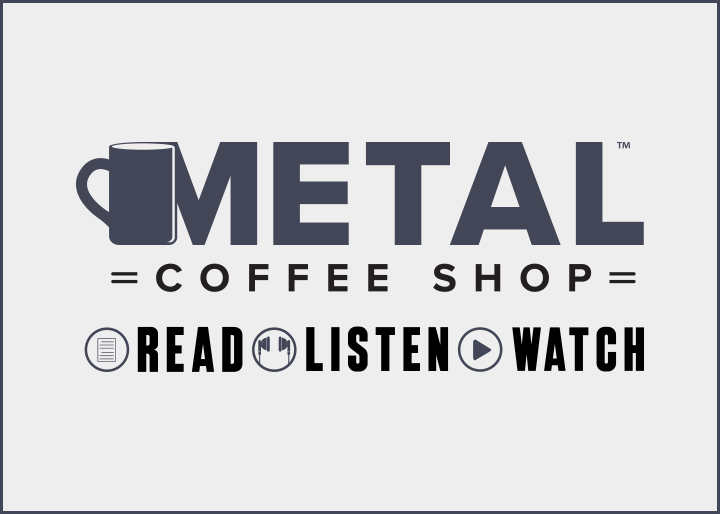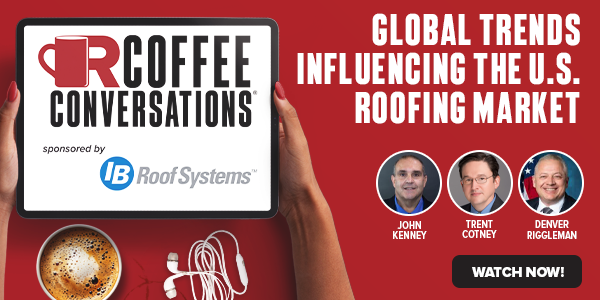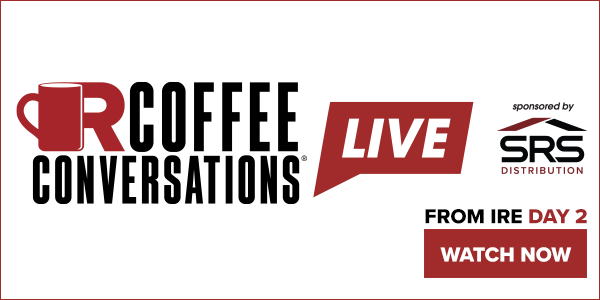European Trends Influencing the US Roofing Market - PODCAST TRANSCRIPT
July 8, 2025 at 3:00 p.m.Editor's note: The following is the transcript of a live interview with Jason Stanley, CEO of IB Roof Systems, and a panel of experts. You can read the interview below, listen to the podcast or watch the recording.
Intro: Good morning and welcome to Coffee Conversations from the Coffee Shops. My name is Heidi Ellsworth and we are here today to really talk about something that is on everyone's mind. Everyone is watching the news every single day and that are global trends that are influencing us, with everything that is happening in the US and internationally. We wanted to bring experts in to really talk about what we should be looking at in the construction, in the roofing metal industries, to really think about how is this affecting us from tariffs, to immigration, to new technologies and new products that are coming from us around the world.
So before we get started on this great topic, I do have some housekeeping. Remember, this is being recorded and it will be available within 24 to 48 hours. And of course, the chat is open. This is all about all of you. We want the conversation. We want to know who you are, where you're from. I already see Sherry Miles in here. Good morning, Sherry. So excited to have you all here this morning. So please, in the chat, just let us know who you are, where you're calling in from and throughout the show, please ask questions, make comments, observations. We want to know what you're thinking and we want to answer all of your questions.
So let's get going. First of all, I would like to say a very big thank you to IB Roof Systems for their sponsorship, for their ideas, for everything they do for the industry. Thank you so much for being a part of this important topic.
Okay. I am so happy once again to introduce someone who doesn't need an introduction that most of the people know. And that is Trent Cotney. Trent, welcome to the show.
Trent Cotney: Hey, it's great to be here.
Heidi Ellsworth: I'm always so excited to have you on here. Can you introduce yourself and tell us a little bit about your company?
Trent Cotney: Sure. I'm Trent Cotney. I'm a partner and construction team leader at Adams & Reese. We're a 20-office law firm, about 400 lawyers and work nationwide. I also serve as NRCA general counsel and general counsel to a variety of other roofing associations.
Heidi Ellsworth: Excellent. Thank you, Trent. As always, I'm excited for this conversation. It's going to be great. And we are also honored to have a first-time guest but not the last time. I have a really good feeling about that and that is Denver Riggleman, who is a former congressman I met at the Roofing Alliance. We are so excited to have you here. Welcome, Denver.
Denver Riggleman: Thanks for having me. I'm very excited.
Heidi Ellsworth: Please introduce yourself and tell us a little bit about you and your company.
Denver Riggleman: Yeah. Sure. So Denver Riggleman, a former congressman from Virginia. My company right now is called RIIG. However, we sort of rebranded based on AI automation. Individuals came to us, Heidi, asking for help not only in insurance tech and health tech, but also in trades like roofing on how to automate using the new forms of AI but also data science.
So all of a sudden, we become this sort of over the shoulder troubleshooting company in AI and have exploded a little bit. So now I get to be on here and learn from all you great people about roofing and maybe impart a little knowledge globally about what's going on or at least about what's going on maybe on the Hill or in AI automation.
Heidi Ellsworth: That is excellent. Thank you so much for being here. And you weren't able to attend a couple weeks ago, so I wanted to say thank you so much. We're so happy to have you today. This is great.
Denver Riggleman: Honored to be here, Heidi. Honored to be here.
Heidi Ellsworth: And of course, I am so happy to welcome back, John Kenney. John, as always, I love having you on here. I mean, I'm telling you what, this panel right here, we're pretty excited. Can you introduce yourself and tell us a little bit about your company?
John Kenney: Sure. Yeah. Always excited to be on here, Heidi. It's always a great topics and panel to be a part of. I'm John Kenney. I've been a 45-year plus veteran as a roofing contracting side. I'm now CEO of Cotney Consulting Group. I work with training and growth and operational issues throughout the roofing industry with contractors. The other thing that I do, we don't talk about enough, but I do work outside of the US with Canadian Roofing Contractors Association, the IFD over in Europe and also in UK. It used to be the Institute of Roofing who is now merged in with the Chartered Institute of Building Construction. So that's a lot of exciting things going there and their whole focus is on what we all talk about today, training and where the industry's going. So always looking forward to it.
Heidi Ellsworth: Yeah. I love it. I love it. I've been kind of following both you and Trent as you were getting involved in the UK. Of course, we're in Canada, so I know it's fun to be able to see how things are done different, but how much we're the same all at the same time. So let's go ahead and get started.
So what we want to do today is we really want to talk about what's happening out there and how it's going to affect the roofing industry [inaudible 00:05:16] and construction overall. So let's start high level with what we are seeing internationally with influences around the globe that really are starting to influence, yes, us in construction and roofing, but also us, just as the USA. What are we seeing that are coming through there?
So I'm going to start with Denver and just some of the influences that you're seeing that really as we're working internationally, I know you are doing a lot internationally. What are some of the things that we should be focused on?
Denver Riggleman: I think there seems to be internationally much more comfort with technology when you're looking at what trades are doing. So since everybody here has forgotten more about roofing than I know, so I'll stay with what's going on in China and some of those other countries.
I'm very familiar with Chinese IP and technology growth and I'm looking at robots actually doing trades. So they're utilizing specific types of AI but also data science and graph neural networks for those that are actually finishing Sheetrock, putting up Sheetrock, right? All the things that I used to do as a helper. Doing some of that manual labor, what they're actually joining the seams.
So what's interesting to me is that there's an embrace of this technology internationally that sort of blows my mind and I'm wondering how far we can go in the US. And when you look at the producers that we have of chip technology like Nvidia, when you're looking at other types of chip technology like AMD or you're looking at some of the new stuff that's going out, that's not even large language models. This sort of this crazy stuff that's coming out of certain countries, but the US is leading in that.
Talking to some roofers it seemed like it was interesting some really are embracing technology and even my cousins, I talked to them who own one of the roofing technology, one of the roofing companies. Like, "Denver, we don't know if we want to go this far on technology. We don't know if we trust it."
So what's interesting internationally is you're seeing a lot of people, I think, embracing almost this AI trade specific, not only with robotics but also with automation, tracking supply chains and specifically even with scheduling, conversational AI. So I'm seeing that everywhere, especially as I go to Europe.
As you know, Heidi, I was just in Moldova, Poland and Ukraine, but I also was in the UAE. And when I was in Dubai and Abu Dhabi, I got to see some of these things also in the way that they're doing construction is really technology and AI focus. So for me, it's just sort of this exploding cantaloupe of technology that you see in robotics and automation based on this AI layer, but really based also in other technologies like graph neural networks and things like that.
Heidi Ellsworth: That is so interesting because I am going to say three or four years ago, Trent, you had said with this labor shortage, what's going to fill the gap? Technology. And Denver, you're saying that's exactly what's happening on a global front. Trent, are you seeing some of those same trends?
Trent Cotney: Yeah. Absolutely. I think Denver's spot on. When you look overseas, there's really two trends that I think are kind of coming our way. One is historically, Europe and other countries have always looked towards sustainable roof systems for out of necessity and both just because a lot of the roof systems they gravitate towards the slate, the copper, the higher end roof systems on residential and some of that I think is moving over to the states. But more importantly, we're starting to see a lot of automation, a lot of robots, heightened drone use that is originating in Europe, but also here in the states.
And I think as we continue to face labor pressures with current immigration policy and otherwise, you're going to see this increase rapidly out of necessity. It's got to happen. And I'm excited to see what's going to come up. I think you're going to start seeing an evolution of both the systems that are used and how the systems are installed and it will happen sooner rather than later.
Heidi Ellsworth: Yeah. And I was just at a conference and had a young man come up to me and he had just started a robotics company and he wanted to talk about what he's doing with robotics and how it's doing using AI, I'm really looking at that. So we're seeing it everywhere.
John, what are some of the things you're seeing in your conversations, obviously, with the IFD and a lot of the folks out there? What are some of the influences that you think are going to start influencing the US?
John Kenney: Well, I think you got to look at it a couple ways to wrap up what we've been talking about. I think as far as robotics goes in the construction industry, I would say five years ago we were probably behind, definitely UK had some great leads out in Europe. But I think right now, from what I'm seeing for robots that are able to do drywall, bricking, concrete industry has invested a lot. I'd say we're probably neck and neck. So I don't see a huge gap in that.
AI has made a huge difference worldwide coming into robotics because you can actually control what's going to happen with the labor and movement and how things get done. But Trent brought up a great point on the sustainability difference. There's two major differences between globally and the United States mindset.
First of all, roofing has been a global market for probably 40 years. When built-up roofing started to phase out and other single plasma technologies came in between the mid to late '70s into the '80s, we really became more of a global market as far as roofing goes. Not saying about trade overall, but the biggest issue is, is the mindsets.
In Europe, absolutely they're more for preservative, preservation and long-lasting roofs where we all know, I don't care who you are in this industry, you know that in the United States we are for getting things done. And it's not always a priority for developers and building owners to have long-lasting roofs.
One of the big differences is, I have this conversation a lot with people about when you do the history posts, well, why would roofs last longer then or they didn't last longer? And I'm like, well, even today, overall, the average roof nationally only lasts between 10 and 15 years before replacement. There's a lot of reasons for that. That's not that we're not building durable roofs on the manufacturing side, because honestly, the materials in the US and the materials throughout Europe are pretty much identical at this time and point. It's just the mindset of what the culture's at.
And I don't know when we're going to move into the long-lasting. "Well, I want a 50-year roof and I don't want to deal with it." I'm not sure we're anywhere near close to that.
Heidi Ellsworth: John, I want to dive into that just a little bit deeper because I've been seeing the same thing. I mean, back in my days working with Polyglass, who's a European company that came over and obviously our sponsors, IB Roof Systems, a US based company, but now part of Kingspan who with Kingspan being just such an amazing international company and doing such great things.
But I see some of the products, it seems like that there is some changes, some when you're talking about sustainability, when you're talking about performance and durability, I'm hearing this a lot more. I know that it doesn't always translate into the field, but it seems like some of that is starting to gain ground. What are you seeing with some of those products that are coming from internationally?
John Kenney: Yeah. I would say every product that has the possibility of being a 20, 30, 40, even a 50-year systems here. It's just a matter of the marketplace accepting it as a norm. Now I'm not saying every roof put on globally is a 50-year roof, that's not the case. But they look at sustainability in Europe, everybody thinks of sustainability. How are we packaging it and how are echo friendly?
When they look at roofing, because I sit on a commission over there on sustainability for the IFD and when we were going through all this last year and into this year about what sustainability means to the roofing industry, it was really a turn that I didn't expect. It was not just about having a long-lasting roof. It was about having quality, details and installation techniques so that there wasn't a drop in labor for sustainability.
They found that the roofing materials had the opportunity to last, but they're facing the same problems we are here, labor installation. So that's where they were focusing their sustainability efforts on is how do we get the information to the installers so that they have the training, the knowledge and the wherewithal to have a roof capable of lasting 30 years actually be installed to last 30 years.
Heidi Ellsworth: That's really interesting. And Trent, you're nodding a lot there.
Trent Cotney: Yeah. Sustainability is the conversation about that. And obviously we're talking about it here in the US, but when you look over in Europe, there are really two things that drive it. John mentioned the mindset. The mindset is a little bit different about the longevity of roof systems, but the other thing is regulation. Regulation pushes a lot of the sustainability that's out there.
In the EU, for example, there are what's known as environmental product declarations where manufacturers have to specifically identify embodied carbon values and they've got to be able to identify environmental impacts and to what extent are their PVC take back programs. There's all these different regulations and there's pros and cons to that, right? There's more expense, there's more upkeep. It can be more difficult for manufacturing and the installation side of things, but it kind of goes hand in hand.
You have to have the mindset and you have to have some regulation in order to push that forward. So adoption of that here in the states is going to require threading that needle. And it's always a give and take because you don't want to overregulate, but you also want to make sure that you're having environmentally friendly sustainable products.
Heidi Ellsworth: Yeah. And I want to go down that products road because one of the things that we, there's a lot of conversation out there and I don't think people have a lot of facts a lot of times, are on the tariff. So we have become, John, to your point a more global, we get our product, a lot of products globally, whether it's China, Europe, Australia, we see these products coming in. Now we are dealing with tariffs. So Denver, I would love some of your thoughts that you're seeing just on that bigger picture around tariffs and what we should all be expecting.
Denver Riggleman: Yeah. Listening to John and Trent based on the regulatory environment and when you want to be environmentally friendly and sustainability and you're looking at tariffs, what we were asked by other organizations and we literally had the first roofing organization ask us about this, is how do we match the regulatory environment to what you're building? And that can be done automatically.
So there's other, I want to say and I'm going to get into tariffs. This actually will dovetail, I promise, Heidi, this isn't randomness from Denver today. But when you're looking at what John and Trent said, the first thing I would want to do is codify. We can actually match it on an automation layer and say, "These are the best materials and best business practices for this specific community or this specific regulatory environment." And automatically defines the build case based on what you need and the efficiencies that could be built into that based just on a voice command.
I want to put in this specific type of roof for this and these are the ideas we have on the AI automation layer. What you can do too is look at the tariffs. The tariffs are fairly arbitrary, taken politically out of it, they are and there's 193 countries in this globe that we have more or less. And some people say 199 based on territorial definitions, but about 193.
And when you look at the tariff letters that go out or how that affects the raw material baseline or how that affects supply chain, how that affects what you're paying for those materials, it is possible to almost be predictive.
What is each specific gradation of tariffs? If it goes up 10%, how does that affect my bottom line cost? How do we actually match that to the regulatory environment and how do we match that to our labor and our supply chain environment? Then actually, how do we build that into our scheduling?
Can you completely automate that entire process and vertically integrate it? I think you can. We know we're doing it. The insurance fields, they're trying to do it now. When you're talking about insurance verification, claim adjudications and you're looking at medical supply chains and all that goes into sometimes prognosis. It's pretty insane how you can link all that together.
I think the first companies in roofing that really embrace automation and they're willing to put in that front load, I think it's going to be pretty interesting. Now I also think the first ones that do it, there's going to be some trial and error and I think there's going to be some falling on our face as we try to do this. There's risk to being a first mover too.
So when you're looking at tariffs, how do you absorb those kind of costs when you have labor shortages, when you have supply chain challenges? How do you do that? And I think that for me is that fighting at every level. I think in a government way or political way, you almost have to fight as a tradesperson on how that affects you and your labor.
And then when you throw in immigration or those labor challenges, my Lord. In the military, a furball, right? How do you navigate that furball as you're going into there? And that's why when I'm listening to John and Trent learning every second from them, even on this podcast, on this show. First thing I want to know is to define the problem areas and define all the data that you have for your specific company. And can we query all that data now and then go and look and see how that all integrate?
And I think with tariffs, all the way to supply chain, all the way to sustainability, all the way to the regulatory environment, it'll be the companies that can first combine that all the way down to the scheduling layer and say, "We already know all the factors as much as we can. We're ahead of the competition because we've used AI or we've used advanced technologies to automate and we have somebody that's completely involved in looking at what's going on as far as tariffs and the political structure."
So that's my bright idea for the day, is actually how can you integrate all of that? And with tariffs and the international issues that are constantly in flux, you can automatically ingest those changes and maybe look forward for your company better than other companies can.
Heidi Ellsworth: And that just wasn't available even a year ago or two years ago.
Denver Riggleman: No.
Heidi Ellsworth: Yeah. It's moving that fast.
Denver Riggleman: Well, you think November, ChatGPT came out in November of '22, but if you're looking further back, the machine learning explosion in the late 2000s, people are like, "Wait a minute. There was machine..." Yeah. I mean, we're looking even as far back as 2001, there was a really robust machine learning environment in the DOD. Why? Well, I sort of ran it. Right?
When I went to the Pentagon and NSA after 9/11, I was put right into this bizarre program from this top secret air force acquisition activity that was looking at using machine learning to identify communication paths and this is 2002.
Heidi Ellsworth: Wow.
Denver Riggleman: So now we're just seeing the big bloom 20, 25 years, after really everybody's thinking this way. We're seeing this big bloom now. And I think who knows what's going to happen 25 years from now, but I think people need to get on that automation bus sooner rather than later.
Heidi Ellsworth: Wow. I love it. Okay. We do have a couple questions in here and I want to make sure we get those in there. This is really interesting. First of all, I want to note Deb Meisel from NRCA, who we love. Good morning to NRCA, it's from Washington DC office and former Congressman Riggle staffer. Congress could use you both back here, Denver. So that's from Deb. And I think everybody agrees.
In the Q&A from Tim. Thank you, Tim. Denver, do you see a use case between drone-based imaging for inspections, price quotes and AI costing and job planning? Does that make sense?
Denver Riggleman: I think that's not just a use case. I believe that's where you have to go. I think with the companies that are out there, which as Heidi you know, my head exploded when people are telling about the companies at the Roofing Alliance, "Man, wait a minute. You guys already have this. This is great. Because I thought this was a great idea for me. What are you talking about?"
But I think you're like, "Oh, you already have drone-based estimates? What the heck's going on? This is great." Because my whole thing was weaponizing drones from the early 2000s in the DOD. So goals-
Heidi Ellsworth: And now it just measure rooves.
Denver Riggleman: Yeah. Well, you say just measure rooves, but my goodness, I was talking to a group and I'm like, "You can mitigate so many safety issues with those type of estimates, but why do you even need somebody on site?" And this is a question for roofers. I'm not saying this like I already know the answer. Okay? This is not a rhetorical question. But can you do it to where when you go from, if you're looking at thermals, if you're looking at infrared, if you're looking at things that we're using in the battle space now, which I'm pretty familiar with.
Can you actually have a drone to the entire estimate? Actually, port that back, gen it up. You already have your email list. You already have that actually loaded for that specific individual where you can actually take a human almost out of the loop. You're going to have to have a QC function with a human, right?
You can't completely take humans out of the loop because even though people are like, "Oh, it's AI, it's actually DI. It's dumb intelligence sometimes." So I think what you're looking at is that use case can be built. The first thing you have to do for that question though is you have to identify all the data you have on hand and where your gaps are in the data to make that happen.
So the first thing that you're going to do is discovery on all your data. So we were at a company yesterday and I'm like, "Hey, is your data all in one place, in one server? How do you actually do it?" They're like, "Well, hell no, Den. We got data everywhere and paper and PDFs." I was like, "I thought so."
Yeah. It was a leading question for me. So once we know where all that data is and we OCR it, use optical character recognition, we can put it in an AI payload. We can see what data you have and then we can map out your exact use cases.
So I think a lot of companies are going to do that. I'm not saying we're completely special, but the thing that we are special at is the type of AI we have. So that question is very pertinent is I think we can do a soup to nuts. What if somebody wanted to do this sort of practice thing? And I'm sure John and Trent are going to know more of the gaps.
I mean, John and Trent opened my mind during our practice when I was talking about standardization of language if you do training apps and roofing. So I think it's learning from the experts and then applying that to an automation level layer and then doing the use case from soup to nuts after you discover all the data. But that question, I think that's where you have to go. I think that's where it's going to go.
Heidi Ellsworth: Yeah. I think it's interesting because I want to bring this back because this is what is happening globally and I mean obviously we're one of the leaders, but we also are seeing this happen globally. But one of the things I want to kind of talk a little bit about is that global influence of equipment, of machinery and how it is becoming AI. It's incorporating those things.
So John, I'm thinking about Leister. I'm thinking about all the metal forming, equipment that comes from Europe. We have equipment coming from all over the globe into the US. And so how is the technology advancing so that as we're consuming that, but also how are some of the tariffs and different things like that affecting our ability to get that equipment too? Your thoughts?
John Kenney: Well, definitely the European manufacturers, like you said, Leister and metal forming equipment's been coming from Germany for decades. And I think a lot of your bigger manufacturers, when I talk to them, a lot of their plant floor equipment that produces things also has a lot of roots and ties back in there. Honestly, that's a hard question to answer about how tariffs are affecting that because the tariff mindset changes a lot from, at least, what I see. But regardless if any tariff, whether it's five or 10%, 20%, it doesn't matter what it is.
If a tariff's on anything, the price is going up. It's as simple as that. So if it's a 10% tariff on equipment coming in from Europe, then equipment's going to cost 10% more than it did prior to the tariff. So I mean, that's not my field of expertise to understand where policy's going, but for sure, I know for me as a contractor, consultant, understanding the construction industry, there's a lot of unsurety about where it actually ends up. So that's where I see.
Heidi Ellsworth: And I think, to kind of sum to that same point, really it does go back to, okay, yeah. We may have tariffs or maybe increased pricing, but is it also labor savings and is it filling a gap that we need from that technology? Trent, you have been on the forefront of this in the industry for so long. What are you seeing on the types of equipment, whether it's drones, Denver's talking about or I mean, I was blown away with looking at some of the heat welding machines out there and the technology that's being embedded. I know I saw Josh is here from OMG, they have some amazing technology. What are you seeing?
Trent Cotney: Yeah. It's pretty incredible. And I encourage anyone that hasn't had an opportunity to go to the DACH and HOLZ show in Germany. It's larger than IRA. It's a huge show where all the European manufacturers and others outside of Europe go as well. And it's just got incredible stuff there.
You're going to see the latest and greatest and they tend to, I would say, Europeans in particular, a lot of the machinery and equipment that we're seeing in the roofing space comes from there. So to kind of piggyback off of John's point, with the current tariffs, lay of the land and you mentioned Deb was on the line, kudos to Deb, Dwayne and Terry and everybody over at NRCA, they're doing a fantastic job.
I don't know how they do it, honestly. I can't keep up with it. Just trying to figure out what the latest news is, but they're on the front lines lobbying for our industry. And I think keeping that front and center is important. We want to be able to get this great equipment in. We want to be able to keep our roofing industry a global industry so that we had the capability to benefit from new technologies and hopefully start doing some of that ourselves. But navigating that's an ongoing challenge. And I just hats off to those guys. Again, I don't know how they do it.
Heidi Ellsworth: Well, next week we're going to be at the NRCA mid-summer meetings and there's all kinds of excitement over here at the Coffee Shops because it's one of our favorite things to do is to go to the NRCA meetings and James is on all of the roof pack and the government affairs and all that.
So we're going to be hearing from them and sharing that information back out. But I do think that that advocacy is really important right now. And let's talk a little bit about immigration. Immigration is definitely affecting our industries and what's happening and I'm going to start with you, Trent. Just what you're seeing and how, not just in the US, but globally as we're seeing that effect on getting our labor.
Trent Cotney: Yes. I'd say since January, I always joke around, nobody ever calls me with good news. I don't get that phone call from a contractor saying, "Let me tell you how much money I made today." It's always the sky's falling, the roof collapsed, whatever it is. And that's good for me because it helps me understand what the big issues are.
By far, the top two things I'm getting phone calls about are still tariffs and immigration. Recently, I've had a lot of questions about the One Big Beautiful Bill and how that impacts taxes and things like that. But tariffs and immigration by far and immigration in particular. Throughout the United States and this is not a Red State or Blue State thing.
I've had reports of ICE raids on projects. ICE raids in home offices, increased [inaudible 00:29:57] audits. So understanding and navigating that both from an employer standpoint and what you can do to assist your employees is an ongoing challenge.
My concern is that it is directly affecting both sub crews and RWT labor. And as that labor pool shrinks, it's going to cause labor rates to increase. So the immigration policy and I think, again, none of this is political, right? I'm looking at it strictly from a construction or roofing standpoint. I understand the need to secure the border and I understand the need to have immigration policies in place and appreciate that and understand that. But at the same time, I think it's very important that we have some form of temporary protected status or some way to allow workers to work regardless of whether it's construction, agriculture, hospitality, come over, be tracked.
We don't want criminals, but they'll pay taxes, do all that kind of stuff. But we've got to have a legal means and an easier way than the H-2B process, which quite frankly just doesn't work. And I know, again, to shout out Deb, Duane and the gang over at NRCA, they're on the front lines of advocating for that.
I know it was one of the conversations that we talked about at Roofing Day in DC, but you can't have one and the other. You can't have zero tolerance policy when it comes to immigration and not have a mechanism to allow workers to come in the US.
Again, I'm kind of on my soapbox a little bit, but all I hear from contractors day in and day out is how either their crews got rounded up, they had no shows, they can't get labor and this goes everywhere from Florida to Washington. It's all over the US. So big issue. Probably in my opinion, the biggest issue for the industry right now.
Heidi Ellsworth: Yeah. We're seeing the exact same thing and Denver, you are nodding. What are you seeing on this front?
Denver Riggleman: Well, goodness. It's hard. So I'll tell a story really quick. I was with Dairy Farmers in 2019 and there was about 30 of them all vote Republican. And I'm in one of the southern counties, I won't mention it in Virginia. I had 21 counties in my district.
And I remember there was an old Republican on the right side, had a bunch of younger farmers and he goes, "Denver, you know what the most Republican thing you can do?" I said, "What's that?" He goes, "Amnesty like Reagan in '86, right?" Like, "Okay." And then the whole place exploded. Right? Half of them going, "Let's do amnesty. We need our labor." The other half are like, "I don't know."
So I think what Trent's saying, right, is what we're seeing right now I think is this lack of consistency in policy. And if you have arbitrary decisions that were being made, whether they're right or wrong is Trent's trying to say and John, right, let's take the politics out of it, you can, is that the biggest issue I had was H-2A and H-2B workers in my district.
And that same individual pulled me aside. He goes, "Denver, I want to be voting for you, but you got to somehow help us on immigration, but we can't tell people you're helping us on immigration." That's a quote.
Heidi Ellsworth: Wow.
Denver Riggleman: Right? So you have this, again, a furball of people who know the immigration has to be fixed, but there's almost this zealotry in saying, "We have to fix the immigration problem by zero tolerance." But then how do you actually streamline a completely broken system? Trent could not have stated that any better on how broken that system is for H-2As and H-2Bs.
And everybody who's on here who works with H-2As and H-2Bs are probably going, "Yes, Denver. Yes. We know. We know." And me trying to fix it got me sideways with both the Republicans and the Democrats. So I became very apolitical in this. So very strong border based on my security background and if we had to go full amnesty in certain specific positions of people who are working, who are non-criminal, we can do that if we have the willpower to do that.
We can do both. There is nuance. It doesn't have to be a total left or total right thing. There can be nuance. And I think that what's incredible when you're talking about the challenges of lobbying is how do you throw consistency into your message?
So if you're going to a representative who says zero tolerance. Like, well, your district right is 65% rural, so how are you going to do that? Are you going to be selective in your immigration policy from urban to rural areas? How are you going to define that? Is that even the right way to do things? That seems pretty crazy.
So what do you have to do, I think is if anybody's lobbying me and I've been lobbied by thousands, right? Is that the first thing people usually ask for is consistency of policy. What are we actually dealing with? And I think that's the issue that you have right now is not whether it's a left or right issue, it's an inconsistent issue based on arbitrary decision-making.
And when that happens, then you have issues with labor and trying to forecast what you want to do in your business, trade and forecast how your business wants to run. And I think that's a crime. I don't ever think you should have government getting in the way based on inconsistencies. There should be consistency of policy that can balance strong internal security with a very robust legal immigration policy that allows for labor in these specific types of trades.
We can do both, but once you get into tribalism and the political side of it, it makes it very difficult. And here I am, people ask me to run on the Democratic and Republican side, which is the most bizarre thing you can imagine. And I think a lot of it has to do with what is the consistency of policy that the roofing lobbying can ask for and say, "Listen, just tell us what's up." And I think that's the toughest thing today.
Heidi Ellsworth: I think everything we've been talking about, consistency and fighting this uncertainty is key. It's just key to business overall and why we're seeing some of the strain, John, you and I are talking about this earlier. The strain on the economy that's going on is being forced by that uncertainty and lack of consistency that it's 100%. I do want to say I'm so happy, Reid. Hello? Reid Rivel is on today.
Denver Riggleman: Oh, Reid's on.
Heidi Ellsworth: Yeah.
Denver Riggleman: Like good friend.
Heidi Ellsworth: Special shout out to the cast today. Great topic and wonderful to see and hear from my friend. Rep. Riggleman. Thank you. So glad to have you on here.
Okay. One of the things I want to kind of talk about too, is and I've heard this in roofing for so long, is that the training, the education, the professionalism of roofing professionals around the globe is so much better than the US. And that's one of the things, I know, in fact, I'm going to point out when Reid came in as CEO of NRCA. That was one of his main things he talked about is pride of roofing.
Roofing respect, of really understanding what amazing, how professional and great our installers are and what they're doing. In Europe, John, we see master craftsmen, master roofers. I mean, it's just talk a little bit about that influence and how we've been working on getting some of their concepts into the US.
John Kenney: Yeah. So it's interesting. I think over there what really drove a lot of it was self-driven throughout the industries and construction to be apprentice programs originally in Europe were up to 15 years. Now they've gotten away from that because that's a long time to be apprentice.
They're looking at the same two to three year programs that we look at over here. But you can't go and work in a lot of these countries over there unless you go through these regulated programs and get your cards for whatever your different levels of experience are.
Now that's basically going back to, we talked about regulation and why it's needed. We don't have that over here. I think our training programs, that's one of my specialties is training. And I work with a lot in between UK and Europe on how they do their training and I sit on their committees. And even in Canada, it's very similar.
I don't think we're behind on our skills level training. I think the problem is we are such a large country with so many open doors and windows and possibilities of how people train, training more or less I think still in a whole, even though we have better availability and a great job NRCA has done over the years with it and other organizations, it still falls onto the contractor.
The difference is in Europe, it falls onto the schools and the techs and you have to go through that and it's not onto the contractor's back. I think that's the biggest single difference between the two areas.
Heidi Ellsworth: We're seeing this, I mean, we were just at SkillsUSA a couple of weeks ago and it was so awesome to see thousands, thousands of vocational students there competing and we had over 21 competitors on commercial roofing. But I think that training and really getting that in there.
Trent, you were nodding. What are you seeing as some of the global effects that are coming in on how we train apprenticeship programs, that next generation?
Trent Cotney: Yeah. John kind of put a [inaudible 00:39:10] where the apprenticeship program in Europe is a lot more robust than it is here in the states as it relates to roofing and all trades. But I think you're starting to see a sea change in the mindset of how we look at trades here in the United States.
For the longest time, VO TECH was gone. You had to go to college. That was the only way to go. But you're starting to see that change a little bit. And I think some of the regulations and other things that are out there are kind of pushing that way as well. And the recent bill that passed, if I remember correctly, both the section 529 that you would typically use for college and Pell grants, you can now use it for short-term training or credentialing, some of which I'm assuming can be used for VO TECH type stuff.
Obviously, I defer to the experts Deb and gang on that. But I think that the mindset is changing and I think people are starting to be proud again, to be laborers, to be in a trade, to be a contractor. And that's a good thing to see.
We're not 100% where we need to be at, but the rhetoric and I think the mindset overall, we're starting to see that shift and I'm very proud of that. I think that's something that's been a long time coming.
Heidi Ellsworth: It's so true. And Deb does say, "Yes. That is accurate. Expanded 529 and Pell Grants for trade programs." We've been talking about that for a long time at Roofing Day, so that's really exciting.
I think one of the things that I'm seeing a lot with the youth and I'm kind of circling back around, that when we're looking for that next generation to get involved, there is a huge interest in technology. I mean, we saw that at the SkillsUSA. How much tech is there? AI, I mean, all of this is the kids are learning how to do this and how to apply it within the trades and within the vocations.
So Denver, I'm going to bring that AI back to you when we're talking about training and also just looking at the future. If we have all of these machines that you talked about at the very beginning that are coming globally into us and all of the technology, someone's got to put the roof on, but they're going to be putting the roof on using a lot more technology. So that training is going to have to change a little bit.
Denver Riggleman: I wonder if there's going to be a robotics roofing coordinator before you know it, right? Where you have six robots climbing on there with one guy with a controller, when one of the robots gets crazy and starts jumping up and down, you could just shut it off like bad robot. I wonder if we're doing, have the bad robot thing that's going to happen with coordination. But when you talk about what's going to happen is that I think if you really, for me, my daughter, she got her master's in game design and virtual reality. That's it.
Heidi Ellsworth: Wow.
Denver Riggleman: I mean, that master's was not available when I was coming up. That was not available. Maybe an Atari operator when I was coming up. So I think it's going to become more hands-free. I think it's going to become natural language queryable. And I think what you're going to see are apps where the whole training is right on this phone based on how do you put in a ridge vent.
Now people are like laughing, "Denver, there's 4,700 different types of ridge vent." I knew John would tell me. But it might get to that point, well, I know it's not going to [inaudible 00:42:36] is where everything's going to be done based on voice direction. If you're actually talking about supply chain, you're talking about scheduling. "Put John on the job at 3:50. Go ahead and do the route analysis form right now." Which we know we can do already in certain other things that we're doing. Correct?
So I think you're going to go into a hands-free world and I think that's really going to attract young people where they're like, "Hey, everything could be done on an app or on my phone. I don't have to talk to John on the telephone. I don't actually have to talk."
I remember my daughter even said, "There's some kids who won't talk on the phone now. They will only text and they only will talk on the phone if they get permission through a text." I mean, it's insane to me. I would rather just call. But I do think that training is going to become more hands-free, it's going to be more natural language and AI is going to allow us to do that. But also when you get into quantum computing, which is going to come next and you're going to get into quantum intelligence, you're going to see where it's actually sort of predictive, where you have to go in the next job.
It's already going to tell you when the next scheduled maintenance is going to be. It's going to tell you how it actually applies to the warranty. It can actually tell you what the sustainability issues is and the regulatory issues and what you definitely have to do to pass inspection. And my guess is inspections will even be automated in the next 15 to 20 years.
So my thing is this, it's almost like there needs to be a traditional training line and then a Skunk Works training line. Almost like a future training on what it could look like in the future or to give that sort of this is what roofing could look like in the future. And I don't know if anybody's doing that. This is me talking pie in the sky stuff because I worked Air Force Skunk Works, when you're looking at future stuff and building future technologies.
What does the future look like for roofing? What does tech look like for roofing? For me, the first thing it's going to be, it's going to be supply chain, it's going to be scheduling, it's going to be help desk, but it's also going to be from soup to nuts. From the time you actually go to that person and estimate the job with the drone, to when you put a crew out there, I think all that's going to be automated.
I think it's going to be completely automated with only one person in the loop that's actually doing the QC. And I think that's where we're going. And I would say that's going to happen. The first companies that do that, they're going to mess up, they're going to screw up, they're going to have people. But once that is actually solidified, AI just for automation, not for a bunch of robots telling you what to do, but just for that simple automation layer is so robust. I think we're going to see that next five years, next 10 to 15 years, I think you will see sort of auto roofing and things that can go up there very quickly and get a roof done. But I think right now it's the automation layer.
Heidi Ellsworth: So is this happening? I know you kind of mentioned this a little bit at the very beginning of the hour. Is this happening, what you just described, are you seeing this happening in other countries? Are we behind or are we kind of in a foot race right now with other countries?
Denver Riggleman: I don't have John and Trent's knowledge on sort of what's going on globally as far as training and things like that. But I do know when you go to the UAE, the automation skillset and what they're doing is so far beyond so many different areas of our country. But the UAE only has 13 million people. We have 340 million people.
So I think it's going to be very specific to the company and how far they want to go with using their overhead and R&D funds and their margins. There, you have a lot more consistency of policy. Now it's also an absolute dictatorship, the UAE. So there is going to be consistency of policy for an absolute dictatorship. But what I'm saying though, in the US, I think it's the first companies and the state specific legislatures who model for consistency or lobby for consistency in policy and they can somehow simultaneously invest in technology.
What I'm seeing overseas is so crazy, it's so forward-thinking. And as you guys know, there's a lot of Chinese tech in the United Arab Emirates. It almost is mind-boggling. And I do think there's certain areas of the United States that are very far behind and almost afraid to embrace that tech, but it's how they find that investment line to look at increasing their margins in the future by taking the hit now.
And that's a very tough decision at the business level. I would not want to make it. I'm doing it for my company, but we are seeing this and that is what we are going to do is to push forward with R&D on the AI automation layers for trades like roofing, but also for insurance tech and things like that.
So yes, it is forward-thinking in other areas, but as I think John or Trent pointed out, our population size makes it much more difficult, especially with 50 different states with 50 different regulatory environments.
Heidi Ellsworth: That's it. Trent, as contractors are listening to this today and then I'm going to ask, Josh, I'm going to ask your question next. But as contractors are listening to this today or manufacturers, distributors and they want to look at the UAE, they want to look at Europe, they want to look at China and see some of the products, the technologies, those types of influences that can start incorporating to their business to be forward-thinking and to be in front of it. What kind of risks are there? Legally, what should they be kind of thinking about and what are some of the risks involved?
Trent Cotney: Yeah. So anytime you're adopting any kind of new technology, there's always risk associated with that, right? There could be huge reward but there's also risk. And it's interesting in listening to what Denver was talking about, there's a book that I always remember. I think it's called The Technological Society. It was written back in the '50s. And in this book, they talk about how technology will outpace our ability to control it.
And this kind of touches on the singularity, which is that point where AI gets more intelligent and capable of growing itself without our control. Part of that is understanding that as roofing contractors or manufacturers or distributors, that what we need to be doing is instead of shunning it is embracing it and learning it as best we can.
And one of the things that regardless of whether, I remember when drones came out and drones first started to be using, making sure that you talked about things about placing drones in a separate company for liability purposes and having disclaimers and making sure that your operators are FAA approved. There's all these standard operating procedures and additional rules and regulations that need to be done.
With regard to AI, one of the things that we're doing even now is making sure that employee manuals contain an AI policy so that it's very clear that you're covering things like bias, plagiarism, making sure that you are following certain protocols and having things vetted by management if you're using it for social media or marketing.
There needs to be guardrails. There needs to be some guardrails, as long as we can have guardrails. And I think it is upon us, this is not a future thing. This will happen quickly, quicker than we anticipate. One of the things that I've seen that's interesting is that deadline for that singularity point where AI is smarter than we are and basically controls itself. That deadline keeps going back and back and back and it was, "Oh, that's 50 years out." Then it's 25 years out and it's 20 years out.
And if you're using AI, you can already see that. You can see how that would happen because what was available in 2022 is nothing like what's available today. So my advice to anyone that's listening is make sure that both your documentation, your contracts, all that kind of stuff, if you're adopting new technology, that you're considering disclaimers, you're considering how to shield yourself from liability and make sure that you've got proper insurance coverage.
Heidi Ellsworth: Yeah. And I want to say when we say technology, that's not only AI, that's not only software, but that's also new technology and products and the types of products and everything can apply to what you're just saying there, Trent, because-
Trent Cotney: Absolutely.
Heidi Ellsworth: ... we're seeing a lot of stuff come in and we've always been one of the first ones. So we have a question from Josh. How about augmented reality? So Denver, I'm going to take that over to you.
Denver Riggleman: The differences between virtual reality and augmented reality. I love this stuff. Yeah. So I think when you're looking at augmented reality, we were just... I don't know who asked that question. I don't know if they were in our meeting yesterday. So now I'm a little bit weirded out that I'm getting this question. But when you're talking about augmented reality, I think that's something that's going to happen because we were wondering about training with virtual reality or augmented reality, which was brainstorming with my guys. And like I said, with my daughter, getting her masters in virtual reality and helping build, what is it, GTA VI, right? Grand Theft Auto VI, the video game with Rockstar Games.
You're wondering now with augmented reality and virtual reality, can you do the training in a virtual way and then send somebody to a roof with augmented reality where it's automatically looking at what the length of the roof is, what you're going to need. It's giving you specifics that you're probably, if you have to look through a sheet.
Now, again, I'm not a roofer, but what do you need while you're up there? And what is the safety of augmented reality with depth perception and things like that, right? But if you're using augmented reality, you have this amazing ability to do things. And as you know, augmented reality with facial recognition is already very robust.
We can do identity resolution. If I'm walking down the street and I see you, Heidi, with an augmented reality glass, I actually can know who you are. I can access four or five different identity resolution databases from cheap to expensive. I have your address, every email you've ever had, every phone number you've ever had. This is true. Guys, I know of which I speak because there's nobody on here that I can't find your address in three minutes. Nobody.
Heidi Ellsworth: Wow.
Denver Riggleman: So I have you, right? I mean, it's just that depending on what databases you subscribe to, you guys know you can go to automatic white pages and stuff like that, but there's other things out there that are so robust that I even know your car and your license plate and your VIN number. And so this is not as hard as you might think on the augmented reality side.
So I think that's where we're going. I think that's where you have to go for speed and efficiencies. The flip side to augmented reality, it's bulky right now. It still has a way to go, but I'm telling you, if you're looking at virtual reality in a training environment and augmented reality and training and operational environment, I think you're starting to see where I think we're going to go with training because why can't we?
I was just training in virtual reality shooting down Russian drones in a basement using virtual reality and augmented reality goggles.
Heidi Ellsworth: Wow.
Denver Riggleman: So I guess what I'm saying is that's a great question. That is where it's going. And I think it's something that I would say in the next few years, I think we're not even going to be asking the questions about the value of augmented reality.
Heidi Ellsworth: It sounds like a future coffee conversations to me right there.
Denver Riggleman: Yeah. It could be.
Heidi Ellsworth: And Josh says, "We use a platform called DeepHow to train our operators. Augmented reality is a logical extension and could be great on the roof." So yes, Josh, we're on. This is a topic coming up.
Denver Riggleman: I agree.
Heidi Ellsworth: That's going to be great. We could go another hour so easily. This has been so amazing. So I do want to leave this a little bit on just some exciting fronts of the influence we're seeing globally coming into the US and just the role that the NRCA is playing and the role that John Kenney is playing, the IFD.
And so I'm going to bring up this again. And John, I just want to talk a little bit about, first of all, we said it a couple times and I don't know if people know, but what is the IFD and what have you been seeing? I'm showing pictures here from the Young Roofers Competition where the US participated for the first time last fall. The Coffee Shop were there. We were very excited about that. And these are young people from across the globe, China, everyone. So tell us a little bit about that, John.
John Kenney: Yeah. So IFD, to make this simple, to put in English translation is the International Federation of Roofing. Okay? That's [inaudible 00:54:56]. And Germany, where they're based out, roofers are known as dock deckers. And you can see by one of the photos there, they have the outfit on.
That's almost like, as Trent's always said on other ones, you're a rock star. You're at the head of your industry. But what the IFD's purpose besides the training and the things they work on, you think we have regulatory issues in the United States. There is no single governing body throughout all, because it's not only Europe, South Africa is a member, you got China, you got India, they're all members of the IFD participating countries. Russia was prior to the Ukraine war.
So the IFD's mission is and I've worked on a lot of these commissions, is to get a quality recommendation control across all the regulations. Like in Hungary, you do it one way. UK has another way. How do we take all of the different methods of installation for roofing across all the 20-some plus member countries and come out with a standardization of quality installation and guidance?
That's really a main mission of what they've been working on over the last few years. And what you're seeing here is the other part of their main mission, which is the training aspect of it and they have competitions. USA was a big participant this year in the competition and it's from all over the world.
They're sending teams out and this is the roofing Olympics. That's the easiest way I could put it. There's no other way of putting it, but this is the roofing Olympics. So I think there's a lot to learn and take from this to bring over even and I'm starting to see it come across and working more like NRCA. What do they do? They're there to get the standardizations and the guidance and the quality controls because we really can't control the individual regulations. Right?
Florida where I sit now is a highly regulated licensed state, NOAs and Florida product approvals and you've got to do it away. I go to other states and work with contractors and there's pretty much zero regulation. But what is still the goal? You don't hear them say, "Well, we don't care." They want to know how to do it on a quality basis. So I think that's the most important takeaway.
Heidi Ellsworth: I agree. I agree. And I want to point out that when we're looking at this IFD competition, the young roofing professionals from the US went over to compete and they were competing with different products. They were competing with, it wasn't TPO, it was FPO. They had different types of products that they had to learn.
And so these types of activities and I just want to give a huge shout-out to the NRCA for supporting this and for really the global committee to making all this happen. I want to say KPost Roofing Global and Durable Slate all were huge and sent teams over there. But this is the kind of stuff, John, to your point, that as they're training and as we're bringing, they're not only just bringing training and learning how to do it together and then bringing it back, like you said, but they're also bringing new products, new ideas and so this collaboration is probably more important than ever.
Peggy, thank you. She said this was a great event. Thank you for the speakers on Roofers Coffee Shop. So that was excellent. Thank you all.
I know this has just gone so fast and been so great. So if you want more information on all of this, especially on the IFD and what is happening there, please, you can find that all on Roofers Coffee Shop. You can also find it through the NRCA. We are going to definitely be having Denver back and we're going to be talking about some augmented reality.
And what's really exciting is next week and I want to say thank you to IB Roof Systems and I will one more time after this. But in two weeks and Trent and I are going to be on for a Power Hour. So it's going to be just an open Q&A and it's going to be a lot about the Big Bill and what's going on. So please, join us two weeks from now. We're pretty excited about that too.
Gentlemen, thank you so much. This was so informational and great. We had a couple of questions coming in here, so if I didn't get to all of them, I will get those back to you. But gentlemen, thank you so much.
Denver Riggleman: Thank you.
Trent Cotney: It was a pleasure. Fantastic.
Outro: Thank you. Thank you all. And thank you, Sherry. I saw your hand was raised. If you have a question, let me know. You guys, this is just so great. We will be seeing you all in two weeks with Trent and I on Coffee Conversations. Thank you and have a great day.
























Comments
Leave a Reply
Have an account? Login to leave a comment!
Sign In